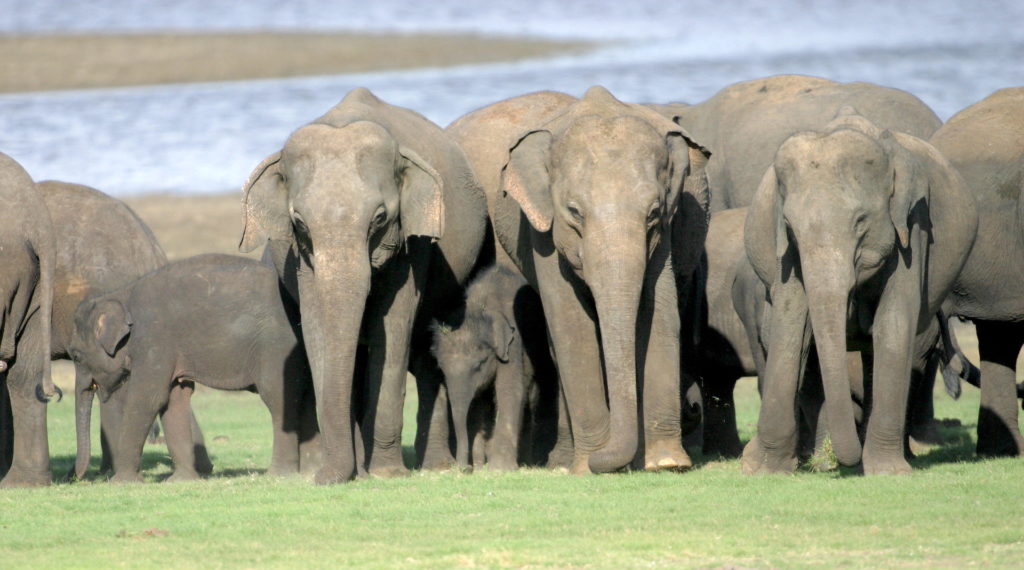Photo courtesy of Gehan de Silva Wijeyeratne
Today is World Elephant Day
The situation of Asian elephants, Sri Lankan elephants in particular, is critical due to the increase in human-elephant conflicts.
Even before the current economic crisis, Human-Elephant Conflict (HEC) victims were in a vicious circle of poverty as recurrent HEC consequences destroyed their farmlands and livelihoods for which they have not received compensation. Resolving this issue was not integrated with protecting the rights of the victims, who have not been consulted in decision making processes. The tentative actions on HEC were limited to ineffective and temporary methods such as expanding electric fences and other traditional ways of chasing away wild elephants. This is where the notion of environmental justice comes to light – why do only HEC victims have to bear the consequences of HEC and, at the same time, make efforts to protect the elephant populations for the benefit of future generations? Regardless of failed and inconsiderate efforts by the government on HEC, the headcount of elephant and human deaths is increasing because the solutions have not followed the human rights principles of participation, accountability, non-discrimination and equality and empowerment and legality.
Amid the government’s blind eye to the increased deaths of elephants and loss of human lives and livelihoods, HEC continues to grow. A proper action plan is absent and the government has no intention to initiate one together with experts in the field. Any conservation plan must not only target elephants but also humans whose livelihoods and infrastructure have to be protected. An integrated process of conservation is the only solution. So far we have failed in establishing such a process not only because of the government’s indifference but also because of not understanding that wildlife conservation should be a scientific matter. It is because of this reason that age-old, ineffective HEC preventive measures are still being practiced such as electric fences.
The recent death of Barana due to illegal electrocution has brought the severity of the causes of elephant deaths to the conservation table again. The iconic tusker died in a national park adjacent to private land and the authorities do not know who’s responsible for the illegal electric post that caused its death. Three people were arrested including the owner of the adjacent private land but the main suspect is evading arrest, believed to be a police officer. This is a significant example of non-inclusive strategies adopted for HEC mitigation that has not resulted from a scientific process. To achieve a cohesive elephant conservation process, Sri Lanka lacks financial and technical expertise including adequate law enforcement in elephant conservation and surveillance mechanisms to monitor the social behaviour of elephants and predict their moves in order to protect both humans and elephants.
To align conservation through social aspirations to human-elephant coexistence, a group of experts submitted an action plan in 2021 to the then president. The plan was inclusive of short, medium and long term recommendations that could convert conflict to coexistence but the authorities have not considered taking a look at it. The scientific knowledge and empirical data are with the field experts and the government only has to put them into action.
We have given little thought to promoting coexistence. Whenever wildlife interfaces with humans, for instance when humans expand into wildlife habitats and when wildlife expands into human dominated areas, it leads to either or both conflicts and coexistence. It is a myth that human-wildlife interactions are always conflicting. The most common barrier to promoting human-wildlife coexistence is inequality and intolerance. Around the world, the costs and benefits of human-wildlife coexistence are shared disproportionately and this is called coexistence inequality. The level of tolerance of humans to coexist with wildlife varies depending on the demographics including culture and awareness. These barriers to coexistence are no exception in Sri Lanka too. The longer we take to promote coexistence to conserve elephants, the sooner we are losing the balance of our biodiversity.
Elephants play a critical role in the ecosystem in terms of balancing biodiversity; losing elephants from the ecosystem is worsening the ability to feed the nation. Despite the negative trends in biodiversity, Sri Lanka still approves the expansion of intensive monoculture that leads to a drastic decline in insects that are the basis of pollination for the food system and squeezes elephants out of their natural habitats, forcing them to enter human settlements. While elephants are gradually disappearing from our ecosystems, rulers say, “It’s just one species we are losing”. Amid such negligence, we are wiping our own existence and digging our own graves.
How many more elephants can we lose before we start to collapse? The tipping point is difficult to predict because of nature’s complexity. But we have already crossed the danger zone. It is every individual’s responsibility to understand that it is high time to halt biodiversity loss caused by removing ecological engineers such as elephants from the picture. As a country, with all the data we have – the number of deaths encountered and the number of existing elephants in the country- we must set a target of a zero loss of elephants by the appropriate time suggested by scientists. It’s all about actions not pledges – act now or never.
The pledges made by sucessive governments such as the establishment of an Elephant Management Reserve in Hambantota, implementation of the biodiversity strategic plan 2016-2022 that directly impacts elephant conservation, the implementation of a national environmental policy and conservation planning of environmentally sensitive areas that protect elephant habitats must be fulfilled.
Let’s act today and hope that future generations can enjoy the value of elephants in the same way we did.
